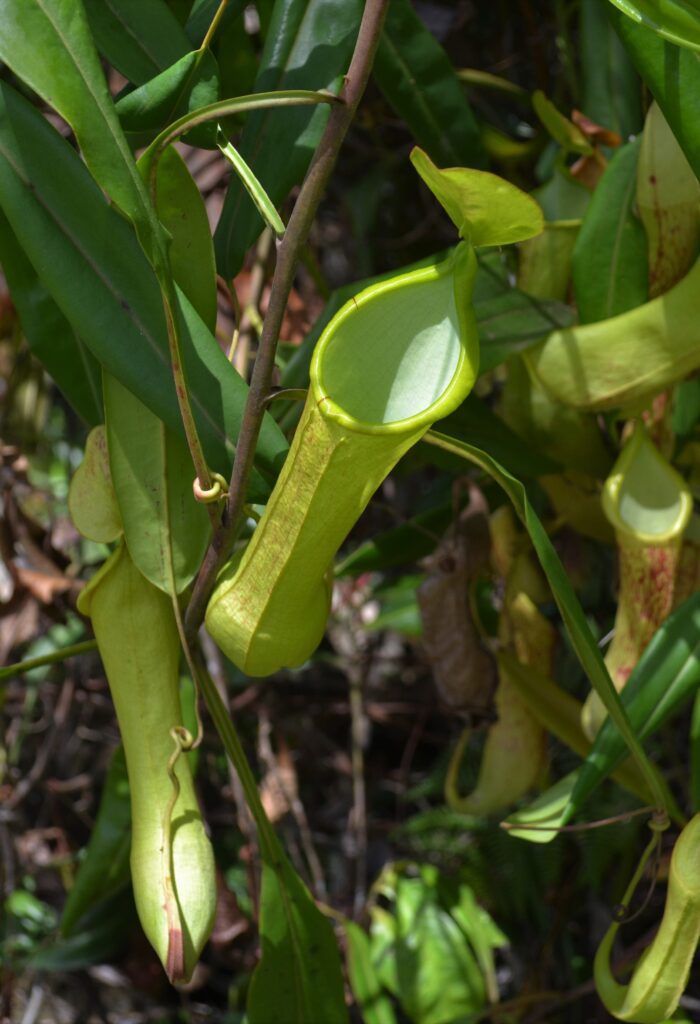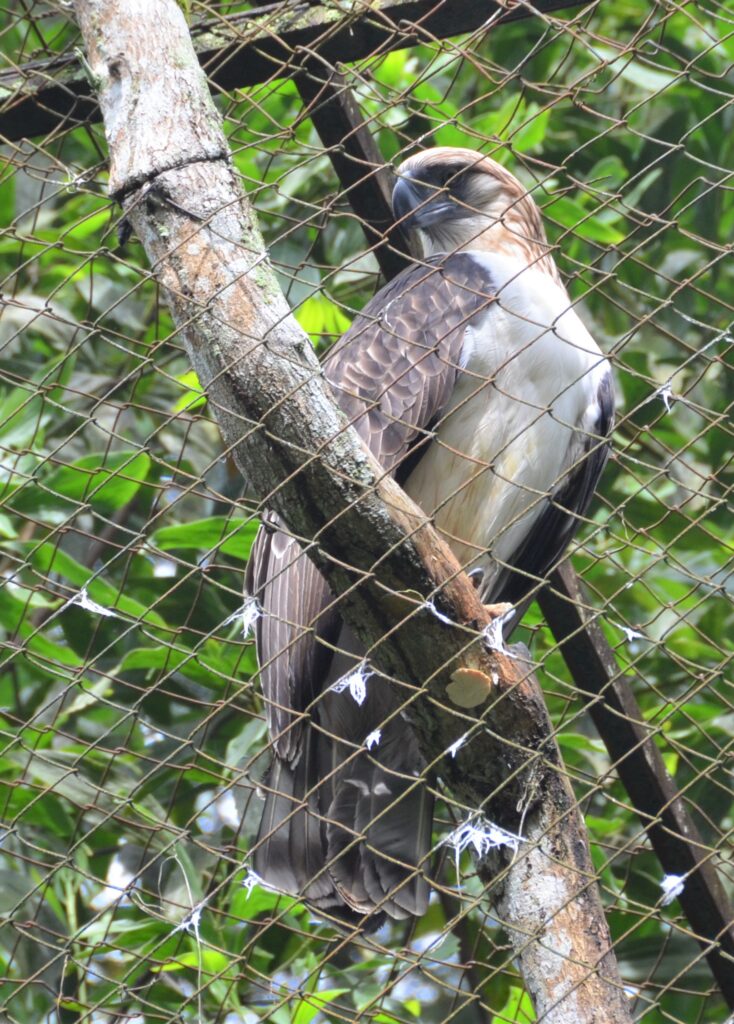Text and Photos by Henrylito D. Tacio
A new pitcher plant was recently found in the tropical upper montane forest nearing the summit of Mount Candalaga in Maragusan, Davao de Oro, the Davao regional office of the Department of Environment and Natural Resources (DENR) reports.
Scientifically called Nepenthes candalaga, it is the 38th species of the Nepenthes in Mindanao. The discovery has made the country’s second largest island for “having the highest concentration of pitcher plants in the Philippines.”
The International Union for the Conservation of Nature (IUCN) considered it a critically endangered species. It means the plant is “facing an extremely high risk of extinction in the wild.”
The newly-discovered species is similar to Nepenthes 𝑗𝑢𝑠𝑡𝑖𝑛𝑎𝑒, another pitcher plant which is endemic to Mount Hamiguitan in Davao Oriental. The two species, however, differ in morphology. The said new species “have 2-3 longitudinal veins running in parallel with the midrib, an orbicular lid and a non-bifid lid spur tip among others.
According to the DENR website, the pitcher plant was discovered by the researchers from Central Mindanao University (CMU). The team was headed by Noel Lagunday, who came to conduct a biodiversity expedition during the reconnaissance climb led by DENR’s regional executive director Bagani Fidel A. Evasco from April 30 to May 3, 2021.
The objective of scaling the 7,800-feet above sea level mountains was “to gather data that would contribute to the pace in proposing the said mountain as a protected area or a critical habitat of threatened species.”
On why choosing Mount Candalaga as the focus of the study, the CMU said the mountain is characterized by having three vegetation types namely: tropical lowland evergreen rainforest, tropical lower montane rainforest and tropical upper montane rainforest. The latter is the part where the new species was observed.
Apart from the newly-discovered 𝑁. 𝑐𝑎𝑛𝑑𝑎𝑙𝑎𝑔𝑎, several endemic species of flora including 𝑁𝑒𝑝𝑒𝑛𝑡ℎ𝑒𝑠 𝑛𝑒𝑏𝑢𝑙𝑎𝑟𝑢𝑚 and other noteworthy Begonia and 𝑀𝑒𝑑𝑖𝑛𝑖𝑙𝑙𝑎 species can also be found in the mountain.

Mount Candalaga is also the home of the famous Rafflesia mira. The flowers of this large parasitic plant bloom from August to November and can expand up to 80 centimeters in diameter.
Just recently, the country’s bird icon – the Philippine eagle – has also been sighted on Mount Candalaga. The environment department said that it was the first sighting of the critically endangered bird which is considered to be the world’s largest and rarest raptor.
The varied flora and the Philippine eagle in Mount Candalaga are part of what ecologists call as biodiversity (short term for biological diversity). It is defined as those that are made up of all species of plants and animals, their genetic material and the ecosystems of which they are a part.
“The extent of an ecosystem or habitat is imprecise; a single ecosystem may cover thousands of hectares or just a few,” the UN Food and Agriculture Organization (FAO) explains.
They include major natural systems such as grasslands, mangroves, coral reefs, wetlands, and tropical forests as well as agricultural ecosystems that, “while depending upon human activity for their existence and maintenance, have characteristic assemblages of plants and animals.”
The Philippines, with more than 7,000 islands, is considered by respected scientists as one of the countries with the highest degree of biodiversity in the world. “(It) is one of the 18 mega-biodiverse countries of the world, containing two-thirds of the earth’s biodiversity and between 70% and 80% of the world’s plant and animal species,” said the Convention on Biological Diversity (CBD) of the country profile of the Philippines.
“The Philippines ranks fifth in the number of plant species and maintains 5% of the world’s flora,” the CBD added. “Species endemism is very high, covering at least 25 genera of plants and 49% of terrestrial wildlife, while the country ranks fourth in bird endemism.”
“There are few places on earth that are richer in biological wonderments, and more sorely beleaguered, than the Philippines,” commented David Quammen, author of The Song of the Dodo: Island Biography in an Age of Extinctions.

American biological science professor Kent Carpenter considered the Philippines as the world’s hub of marine biodiversity. “Species in the Philippines are evolving as we speak,” he was quoted as saying.
“The number (of biodiversity) compares with other countries like Brazil,” said Philippine fauna specialist Dr. Lawrence Heaney of the Field Museum of Natural History in Chicago. “But compare their sizes. For such a small area, the Philippines rockets ahead.”
In comparison, Brazil has a total land area of 3,286,488 square kilometers while the Philippines’ total land area is only 115,800 square kilometers. Indonesia, another biodiversity-rich country, has a total land area of 741,101 square kilometers.
The Philippines is home to about 170,000 faunal species, most of which are insects and are mostly unidentified, according to the Biodiversity Management Bureau (BMB). Twelve thousand plant species and 960 animal species are found in its forests. Of the identified animal species, over 500 are birds and 167 are mammals.
About 98 of mammal species are endemic to the Philippines. In recent years, experts have discovered 12 mammal species in the country seen nowhere else on the planet. The Philippines is home to five of the eight species of marine turtles.
Out of the 500 known coral species worldwide, about 488 coral species are found in the Philippines. There are about 50 species of seagrasses in the world and 16 of them can be found in the country. At least 2,000 fish species are swimming in its waters.
While its biodiversity is among the highest, the Philippines’ ecosystems are among the most threatened. In fact, the US National Cancer Institute lists the entire Philippine archipelago as among the five biogeographical areas in the world considered to be the “hottest of the hot spots,” a hot spot being an area whose high biodiversity is gravely threatened.
“A few decades ago, the wildlife of the Philippines was notable for its abundance; now, it is notable for its variety; if the present trend of destruction continues, Philippine wildlife will be notable for its absence,” commented Dr. Lee Talbot, who was once a member of the Southeast Asia Project on Wildlife Conservation of Nature and Natural Resources.
Noted Filipino wildlife expert Dioscoro Rabor echoed the same sentiment. “It is about time that we, Filipinos, stop making ourselves internationally blind to the real status of our wildlife resources,” he said. “We should face the fact that our country is no longer rich in forests and consequently, of wildlife which used to be a normal component of our forests.”
The Convention for International Trade of Endangered Species (CITES) has listed almost 50 wildlife species in the country that are rare, threatened, or endangered. Among those that are included in the list are five marine turtles, two crocodile species, the Philippine eagle, tamaraw, and dugongs.
“Once these species are gone, they are gone forever, leaving behind an imbalance in ecology and beauty difficult to determine and restore,” observed a committed Filipino environmentalist.

